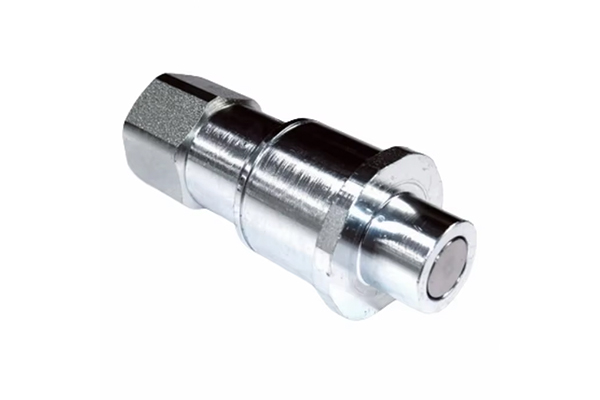How to ensure the durability of Hydraulic Quick Connector during frequent connection and disconnection?
Release Time : 2024-10-23
The durability of Hydraulic Quick Connector is very important during frequent connection and disconnection. The following key measures can effectively ensure its durability:
1. Choose high-quality materials
High-quality metals: Using corrosion-resistant and high-strength metal materials (such as stainless steel or aluminum alloy) to make quick connectors can significantly improve their mechanical strength and wear resistance.
Sealing materials: High-quality sealing rings (such as oil-resistant and high-temperature resistant fluororubber or polytetrafluoroethylene materials) can ensure sealing performance under high pressure and extreme temperature environments.
2. Design and manufacturing process
Precision manufacturing: Use precision machining technology and advanced processes (such as CNC machining, electroplating, heat treatment, etc.) to process connector parts to ensure high precision and high quality, and reduce wear and damage caused by manufacturing defects.
Optimized design: The connector design should take into account structural strength, flow resistance and operator convenience, reduce internal stress concentration, and prevent fatigue cracks.
3. Correct installation and use
Correct installation: follow the manufacturer's installation guide, ensure that the joints are correctly aligned and connected, use the appropriate torque wrench, and avoid over-loosening or over-tightening.
Usage specifications: strictly follow the instructions, avoid using under overpressure and overtemperature conditions, prevent medium contamination and foreign matter from entering, and keep the operating environment clean.
4. Maintenance and inspection
Regular inspection: Regularly check whether the joint surface is worn, deformed, corroded or other abnormal conditions, and pay special attention to the state of the sealing ring and the connection surface.
Cleaning and maintenance: Keep the joint clean, remove oil and impurities regularly; replace the sealing ring as needed to avoid liquid leakage or unstable pressure caused by aging or damage.
5. Use auxiliary tools and equipment
Special tools: Use special wrenches or connection tools for installation and removal to reduce physical damage to the joint itself.
Safety valves and pressure gauges: Install safety valves and pressure gauges in the system to monitor the working pressure and prevent joint damage caused by overpressure.
6. Selection and management of liquids
Appropriate working fluid: Select hydraulic oil that is compatible with the connector material to avoid corrosion of the connector or hardening of the seal ring due to chemical reactions.
Liquid filtration: Ensure that the liquid in the hydraulic system is filtered to prevent foreign particles from wearing and damaging the internal structure of the connector.
7. Operator training
Skill training: Provide necessary skills and safety training to operators so that they understand the correct use of quick connectors, common problems and emergency response plans.
Operation specifications: Develop and comply with operation specifications to ensure standardization of connection and disconnection operations and reduce human operation errors.
The durability of Hydraulic Quick Connector during frequent connection and disconnection can be effectively guaranteed through comprehensive measures such as selecting high-quality materials, precision manufacturing processes, correct installation and use, regular maintenance and inspection, auxiliary tools and liquid management, and operator training.
1. Choose high-quality materials
High-quality metals: Using corrosion-resistant and high-strength metal materials (such as stainless steel or aluminum alloy) to make quick connectors can significantly improve their mechanical strength and wear resistance.
Sealing materials: High-quality sealing rings (such as oil-resistant and high-temperature resistant fluororubber or polytetrafluoroethylene materials) can ensure sealing performance under high pressure and extreme temperature environments.
2. Design and manufacturing process
Precision manufacturing: Use precision machining technology and advanced processes (such as CNC machining, electroplating, heat treatment, etc.) to process connector parts to ensure high precision and high quality, and reduce wear and damage caused by manufacturing defects.
Optimized design: The connector design should take into account structural strength, flow resistance and operator convenience, reduce internal stress concentration, and prevent fatigue cracks.
3. Correct installation and use
Correct installation: follow the manufacturer's installation guide, ensure that the joints are correctly aligned and connected, use the appropriate torque wrench, and avoid over-loosening or over-tightening.
Usage specifications: strictly follow the instructions, avoid using under overpressure and overtemperature conditions, prevent medium contamination and foreign matter from entering, and keep the operating environment clean.
4. Maintenance and inspection
Regular inspection: Regularly check whether the joint surface is worn, deformed, corroded or other abnormal conditions, and pay special attention to the state of the sealing ring and the connection surface.
Cleaning and maintenance: Keep the joint clean, remove oil and impurities regularly; replace the sealing ring as needed to avoid liquid leakage or unstable pressure caused by aging or damage.
5. Use auxiliary tools and equipment
Special tools: Use special wrenches or connection tools for installation and removal to reduce physical damage to the joint itself.
Safety valves and pressure gauges: Install safety valves and pressure gauges in the system to monitor the working pressure and prevent joint damage caused by overpressure.
6. Selection and management of liquids
Appropriate working fluid: Select hydraulic oil that is compatible with the connector material to avoid corrosion of the connector or hardening of the seal ring due to chemical reactions.
Liquid filtration: Ensure that the liquid in the hydraulic system is filtered to prevent foreign particles from wearing and damaging the internal structure of the connector.
7. Operator training
Skill training: Provide necessary skills and safety training to operators so that they understand the correct use of quick connectors, common problems and emergency response plans.
Operation specifications: Develop and comply with operation specifications to ensure standardization of connection and disconnection operations and reduce human operation errors.
The durability of Hydraulic Quick Connector during frequent connection and disconnection can be effectively guaranteed through comprehensive measures such as selecting high-quality materials, precision manufacturing processes, correct installation and use, regular maintenance and inspection, auxiliary tools and liquid management, and operator training.







